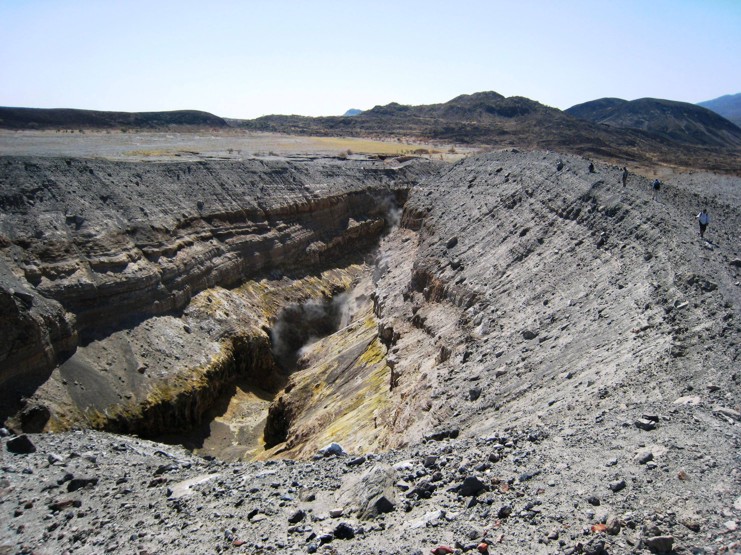I wrote about an idea for a new campaign setting last week. Last night I had an idea for the starting point for the sandbox.
An earthquake rocks a region near a village. The ground opens up and reveals a structure beneath that releases creatures that raid and terrorize the village. Some local hero/adventurer types kill/drive off the creatures, find the buried structure/dungeon, discover great wealth within and word soon spreads. These adventurers could have retired or set themselves up as local power/authority figures, or all been killed in their greed for more.
This premise sets up the whole thing to use a module featuring a dungeon, a commercial megadungeon, or developing my own. The level of flexibility with this is enormous.
Of course, this leads to a boom town with new found wealth that garners the attention of the far off king, who sends a newly ennobled baron, a younger son of a noble to come in and restore order and make sure taxes are collected. This will be a challenge to players, and the degree of taxes taken will depend on how law-abiding the players and other adventurers are, and how lawful and honest the new baron is.
The PC’s hear about this chance for riches and glory, and arrive with lots of others to make their fortune. The damage, from the creatures, to part of the village is seen on the homes & buildings closest to the hole in the earth. Earthquake damage is also evident. Merchants, innkeepers, thieves, and oh so many others have shown up and changed a once sleepy farming village into a boom town that is the center of attention for miles around. Think of a gold rush town, but with magic and monsters. One cold place this in any genre, not just fantasy. Weird West, Sorcerous Space, etc. Or take out the magic and just be technology, whatever suits you.
The native villagers are in shock at the sudden changes to their way of life. Farmers will be chasing people off their fields. This could lead to a localized famine if the crop is poor from all the digging.
Of the various ideas I have had to pull this together, many can be implemented before or after gameplay starts to make things more dynamic. A timeline of events leading up to and after the earthquake would also help move things along.
Ideas:
Make this a one-off introduction to the campaign. This would call for a small dungeon that is soon tapped out.
Make this the center of attention for the sandbox with a megadungeon.
Formerly sleepy area of kingdom that has not seen much trouble for generations, near a kingdom that has been at peace, but the sudden surge in wealth has many claiming ancient rights to the spoils and demanding their fair share. Documents, maps, patents, deeds, genealogies, etc. All presented to back up claims to land, mineral rights, etc.
What might have caused the earthquake? Why now? Who is interested in this?
Supply caravans lose guards and others seeking their fortune. Some merchants come in on a caravan, but set up shop selling supplies at exorbitant prices to adventurers.
Mines/Miners – non-adventuring types will be digging for treasure, not caring to risk life and limb in the dungeon. Pre-cut stone is gathered from the structure as all newer groups have used prior construction materials again.
Local farmer/crafter sets up an inn, uses materials from buildings of the slain families to build/expand.
Constable. – Native villager appointed/elected/selected by town to keep peace/order. Active before arrival of the baron. Baron can arrive before or after game play starts.
When baron and his force arrives, they set a levy and require the able bodied to build a low wall and ditch around the town with watchtowers at each approach. The underground structure is mined for building materials and is like kicking an ant nest….
If a megadungeon, there will be some other entrance(s) that keep re-populating the dungeon. If they dig too deep too fast or venture too deep too fast, they could attract the attention of a lot of bad things….
Place other NPC’s and static encounters around the sandbox. Note which ones were there before the earthquake, and which are new arrivals since. Are any new arrivals due to what the earthquake has revealed? An old hedge witch/wizard would be there before, do they know anything about the structure?
Sages, scholars, and wizards interested in ancient things might show up.
Local village cleric/druids overwhelmed. Shrines set up to strange and foreign gods. NOTE: Idea of the powers and work that in to it.
Other farmsteads in surrounding area.
Fallen towers, other ruins, caves, sinkholes, etc.
Rival gangs of adventurers. As with any boom town situation, one of them has a level of clout/influence the others don’t and takes advantage of it. Turf wars/claim disputes/etc. This may or may not be the original “heroes”. Calls for generating multiple rival adventuring parties.
Tavern Name: The Fallen Paladin – either a heroic paladin fell in battle saving the town, or fell from grace….
Thieves guild of nearest city/large town moves in to get their piece of the action. Or a thief of sufficient level moves in to set up his or her own guild.






